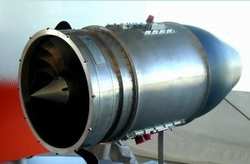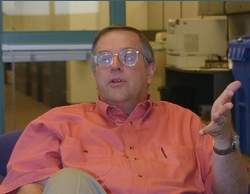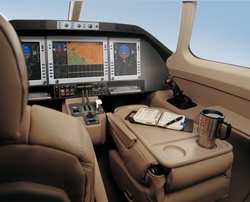ANN's Exclusive Interview With Eclipse's Vern Raburn
 The man who conceived the
market, and brought a small jet so close, so far, talked with us
about what it took to make the decisions that led to the P&W
610F, and the abandonment of the Williams, such a key component in
the original strategy.
The man who conceived the
market, and brought a small jet so close, so far, talked with us
about what it took to make the decisions that led to the P&W
610F, and the abandonment of the Williams, such a key component in
the original strategy.
First, Mr Raburn wanted to clear up some misconceptions in the
rumor mill: "We had zero incentive to cancel the Williams program,"
he said. "We had every incentive in the world to continue that
relationship." As for sniping from the sidelines, some well-known
detractors were not mentioned by name: "There are some people who
claim to know everything about jet engines; all they really
understand is prop engines."
Getting down to the problem, Vern remembered a talk we had at
the AOPA Expo. "It was October 24, in fact," he reminded me, as he
checked his calendar. There was a press report that the Williams
was delivering just 350 pounds of thrust on that first flight. Vern
explained it to me at the time, in an interview that we never got
to print. He said the same thing this week: "On our first flight,
we were 'way down on thrust -- we effectively demonstrated
single-engine performance."
It wasn't any kind of in-flight failure, or anything
unanticipated; it was Summer, in Albuquerque. The air was hot; the
ground was already a mile above sea level. "Turbine engines are
intrinsically normally-aspirated," he explained. "You have to
flat-rate a turbine engine to a very high altitude -- like in a
normalized turbocharged engine -- you can increase fuel burn, and
flat-rate it. You derate it, in effect, for sea level, and don't
get to rated power, until you're at altitude."
The Williams, it turned out, has a steeper lapse rate curve than
some other designs. That translated into lower performance than
expected, though at the time (October), Vern said, "If it's this
good on single-engine power, imagine the fuel savings!"

Sure, but a Ferrari with a Yugo engine would have relative fuel
economy, too. A state-of-the-art jet can still achieve decent
economy, without having to bend so low in the performance envelope.
Still, there was a lot invested in that mutual development, between
Williams and Eclipse. Aside from the relationship between the
companies, though, was the obvious problem that Eclipse was into
this design up to their neck; they realized the huge upset changing
such a major component would bring, and they didn't want to do it.
Mr Raburn told us, "Back when we talked (October 24), we were
optimistic that Williams would solve their problems. We didn't make
the final decision [to change engines] until about a month
later."
It's not 'just an engineering problem,' either.
 Vern continued, "Many said
they didn't think we'd have the guts to change engines, this late
in the program. We had the whole executive staff there, and I told
them there was a real chance that we wouldn't survive [if we went
with that decision]." On the other hand, "All we knew was, we
couldn't keep going with Williams." It's one thing to know what
you're not going to do; and another to know what you are going to
do. "We didn't know what engines we'd be using," he said,
underscoring the corporate vulnerability at that time, just a few
months ago. "I don't think any other company could have done this,
and survived," he ventured.
Vern continued, "Many said
they didn't think we'd have the guts to change engines, this late
in the program. We had the whole executive staff there, and I told
them there was a real chance that we wouldn't survive [if we went
with that decision]." On the other hand, "All we knew was, we
couldn't keep going with Williams." It's one thing to know what
you're not going to do; and another to know what you are going to
do. "We didn't know what engines we'd be using," he said,
underscoring the corporate vulnerability at that time, just a few
months ago. "I don't think any other company could have done this,
and survived," he ventured.
Change engines, though, became inevitable. Once the decision to
look for a different engine was made, though, a whole 'nother
problem cropped up: which one? "Eclipse has created a new market
segment -- the hottest market segment in the industry, from the
A380 down. The segment where people see real growth is our segment
-- the 'light, light jet,' or whatever it's eventually going to be
called. Eclipse has orders, and has proved it's actually building
an airplane. All the engine companies in the world -- and I mean
ALL -- are looking to enter this segment." Suddenly, Eclipse was
faced with a different set of criteria.
 Vern told us, "The deciding factor? That
is impossible to really say. There are so many issues. Take
technical validity -- to a certain extent, you can't fool Mother
Nature, even Williams (EJ22 seen right) can't do that." [When the
Eclipse was originally announced, one of the persistent arguments
against its viability was the general feeling that the Williams
claims were too optimistic; but Williams had done remarkable things
in the past...] "There's also a lot of commercial considerations,"
Vern continued. "There were no differences among contenders that
could be pointed to, where we could say, 'That's it' -- we looked
at customer preferences, company support, name recognition in the
segment we're building -- there was no one thing that made the
choice easy for us."
Vern told us, "The deciding factor? That
is impossible to really say. There are so many issues. Take
technical validity -- to a certain extent, you can't fool Mother
Nature, even Williams (EJ22 seen right) can't do that." [When the
Eclipse was originally announced, one of the persistent arguments
against its viability was the general feeling that the Williams
claims were too optimistic; but Williams had done remarkable things
in the past...] "There's also a lot of commercial considerations,"
Vern continued. "There were no differences among contenders that
could be pointed to, where we could say, 'That's it' -- we looked
at customer preferences, company support, name recognition in the
segment we're building -- there was no one thing that made the
choice easy for us."
Competition?
 Vern Raburn sees Eclipse in front of
a pack of contenders, leading the field in a market he identified.
For instance, he sees Cessna's recently-announced Mustang as
validation for the Eclipse vision, as more companies, pilots, and
other customers, too, are now looking at the 'personal jet'
segment. One other possible competitor, Florida-based Safire, also
brought a comment from the Eclipse chief. Safire has been planning
a composite jet, just slightly larger than the Eclipse, for several
years now, and has just about announced its engine choice... a
couple times. Vern was goaded into sharing his thoughts on that
issue: "On one hand, I respect Safire, because I know how hard this
[business of getting airplane made] is. On the other hand, they've
never announced what they've announced they're going to announce
[their engine choice]." [Note: Safire announced its engine choice,
almost simultaneously with our interview. See story below --ed.]
Vern Raburn sees Eclipse in front of
a pack of contenders, leading the field in a market he identified.
For instance, he sees Cessna's recently-announced Mustang as
validation for the Eclipse vision, as more companies, pilots, and
other customers, too, are now looking at the 'personal jet'
segment. One other possible competitor, Florida-based Safire, also
brought a comment from the Eclipse chief. Safire has been planning
a composite jet, just slightly larger than the Eclipse, for several
years now, and has just about announced its engine choice... a
couple times. Vern was goaded into sharing his thoughts on that
issue: "On one hand, I respect Safire, because I know how hard this
[business of getting airplane made] is. On the other hand, they've
never announced what they've announced they're going to announce
[their engine choice]." [Note: Safire announced its engine choice,
almost simultaneously with our interview. See story below --ed.]
The real victory is at home.
 "One of the things that I'm
most proud of," Raburn concluded, "...the team has kept their heads
down, kept working hard -- they really do understand that what
we've got here is really important," he said; "and that,
occasionally, stuff's going to happen; we've got to ready for
that." He is as confident in his team, as he is in his vision of
the Eclipse itself: "It's impressive that the team has the
attitude, 'OK -- we'll solve this problem, too.' I am so profoundly
proud of them."
"One of the things that I'm
most proud of," Raburn concluded, "...the team has kept their heads
down, kept working hard -- they really do understand that what
we've got here is really important," he said; "and that,
occasionally, stuff's going to happen; we've got to ready for
that." He is as confident in his team, as he is in his vision of
the Eclipse itself: "It's impressive that the team has the
attitude, 'OK -- we'll solve this problem, too.' I am so profoundly
proud of them."
 Classic Aero-TV: The Switchblade Flying Car FLIES!
Classic Aero-TV: The Switchblade Flying Car FLIES! ANN FAQ: Q&A 101
ANN FAQ: Q&A 101 ANN's Daily Aero-Term (04.12.24): Discrete Code
ANN's Daily Aero-Term (04.12.24): Discrete Code ANN's Daily Aero-Term (04.13.24): Beyond Visual Line Of Sight (BVLOS)
ANN's Daily Aero-Term (04.13.24): Beyond Visual Line Of Sight (BVLOS) ANN's Daily Aero-Linx (04.13.24)
ANN's Daily Aero-Linx (04.13.24)








